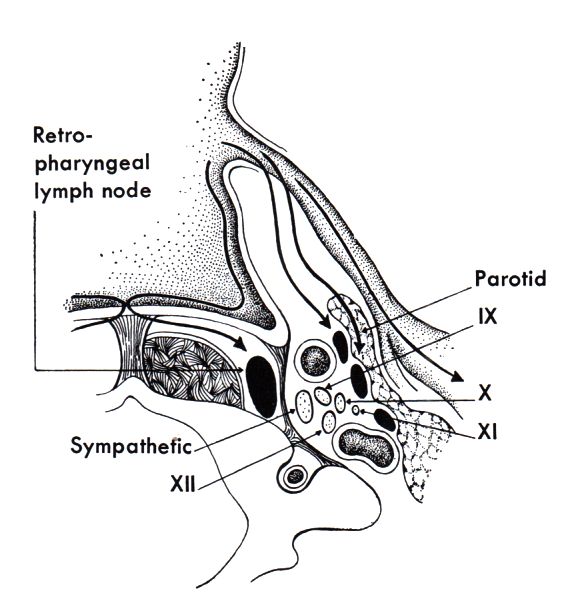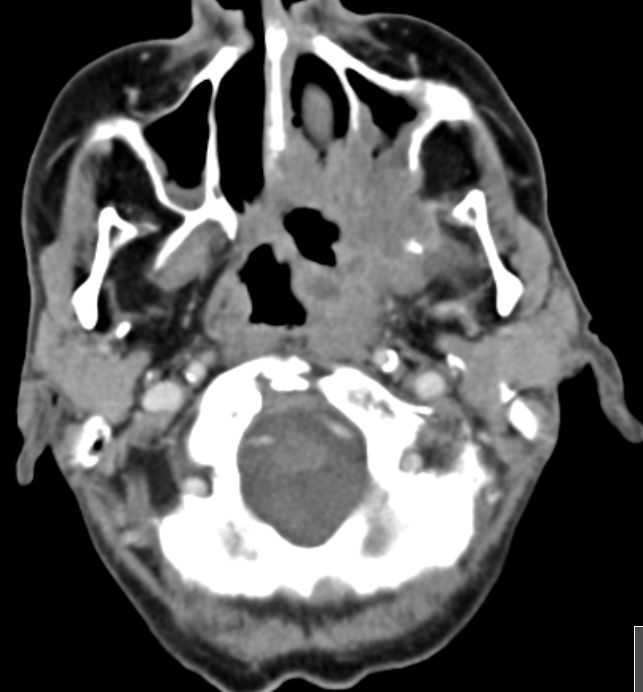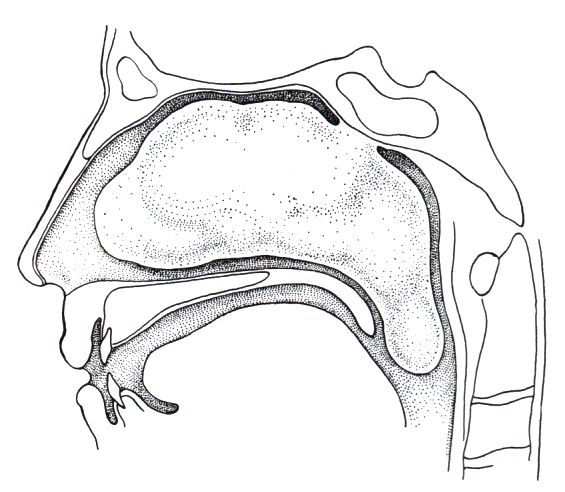zurück
Home |
Nasopharynx-Tumoren |
Allgemeines |
Der Nasopharynx wird nach ventral durch die
Choanen begrenzt. Er bildet das cranale Ende des Schlundes bis zur Ebene des
weichen Gaumens. Er umschließt das Pharynxdach, die Seitenwände mit der
Fossa Rosenmülleri und der Mukosa des Torus tubarius sowie die Hinterwand.
Die obere Fläche des weichen Gaumens bildet die caudale Grenze. |
Epidemiologie |
Inzidenz 0,5/100.000a. Männer - Frauen = 2,2 / 1.
Häufig Epstein-Barr-Virus - AK positiv. Nicht durch Alkohol und Nikotinabusus bedingt. |
Screening |
Bei Nachweis von EBV - DNA im Plasma besteht eine höhere Wahrscheinlichkeit eines Nasopharynx-Karzinoms(1). |
Prognose |
Klinik |
1.Symptom
- Lymphnoten-Metastasen 70%
- Tuben-Mittelohr-Katarrh 30%
- Schnupfen, behinderte Nasenatmung 32%
- Neurologie: Kopfschmerz, Hirnnervenausfall II, IV, VI, IX-XII 23%
|
Metastasierung |
rasche lymphogene und haematogene Metastasierung |
Lymphabfluss in die retropharyngealen Lymphknoten und die Krausecher Gruppe vor der vorderen jugulären Lymphknotenkette.
 |
Staging |
Diagnostik |
59-jähriger Mann mit fortgeschrittenem Tumor des Nasopharynx und Beteiligung von Oro- und Hypopharynx.
Der Tumor ist in die Kieferhöhle eingebrochen und reicht bis an die Schädelbasis.
 |
Morphologie |
| Karzinome |
90% |
| WHO-Typ 1 | verhornendes Plattenepithelkarzinom |
20% |
| WHO-Typ 2 |
nicht-verhornendes Plattenepithelkarzinom |
30–40% |
| WHO-Typ 3 |
undifferenziertes Karzinom, lymphoepitheliales Karzinom, Schmincke-Tumor |
40–50% |
Selten:
- maligne Lymphome
- Adenokarzinome
- Sarkome
|
Nasopharyngeales Fibrom. Fixierung an der Schädelbasis und Ausdehnung zur Nasenhöhle und zum Epipharynx.
 |
Therapie |
Wichtigstes Therapieverfahren ist die Strahlentherapie mit simultaner Chemotherapie. |
66 Gy in 33 fractions per 6.5 weeks by a shrinking-field technique
66 Gy to the planning target volume (PTV) of the gross tumor volume (GTV) of the primary tumor and positive neck nodes,
60 Gy to the PTV of the clinical target volume (CTV) of subclinical disease, and
54–60 Gy to the lymphatics of the mid and lower neck(2) |
Operation |
Radiatio |
Nasopharynxtumoren sind strahlensensibel. |
Chemotherapie |
Nasopharynxtumoren sind chemosensibel. |
offene Protokolle |
Ergebnisse |
HKNPCSG |
Hong Kong Nasopharyngeal Cancer Study Group |
Teil von |
HNO-Tumore |
Onkologie |
| Quellen |
1.) Chan KCA, et al.:
Analysis of Plasma Epstein–Barr Virus DNA to Screen for Nasopharyngeal Cancer.
N Engl J Med 2017;377:513-22.
DOI: 10.1056/NEJMoa1701717
2.) Loong HH, et al.:
Prognostic significance of the total dose of cisplatin administered during concurrent chemoradiotherapy in patients with locoregionally advancednaso pharyngeal carcinoma.
Radiotherapy and Oncology2012; 104:300–304
|
 |


